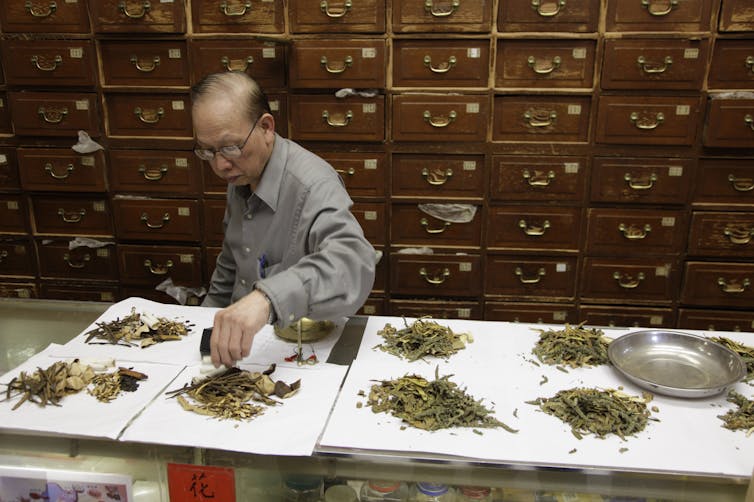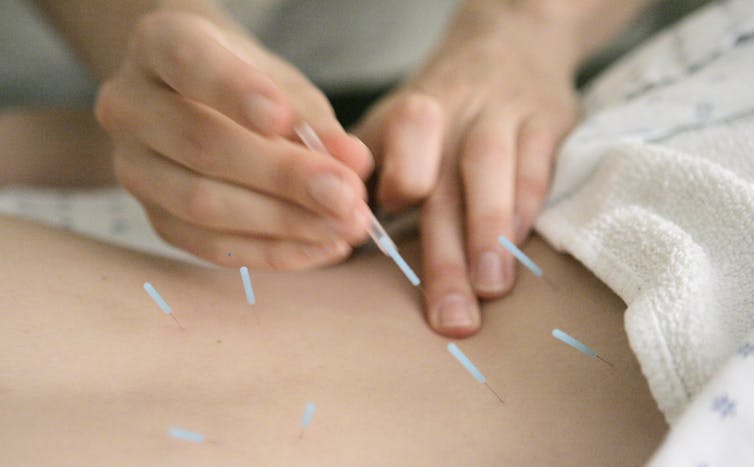Ling Zhao, University of Tennessee and Paul D. Terry, University of Tennessee
For approximately 80% of the world’s population, the first stop after catching a cold or breaking a bone isn’t the hospital — maybe because there isn’t one nearby, or they can’t afford it. Instead, the first step is consulting traditional medicine, which cultures around the world have been using for thousands of years.
Traditional medicine encompasses the healing knowledge, skills and practices used by a variety of cultures and groups.
Examples of traditional medicine include herbal medicine; acupuncture; Tui Na – which is a type of massage originating in China; Ayurveda – which is an ancient system of promoting health through diet, exercise and lifestyle from India; and Unani – which is another ancient system of health from South Asia, balancing key aspects of the mind, body and spirit.
In recognizing that traditional medicine and other alternative forms of healing are critical sources of health care for many people worldwide, the World Health Organization and the government of India co-hosted their first-ever Traditional Medicine Summit. The summit took place in August 2023 in Gandhinagar, Gujarat, India.
The summit brought together health care policymakers, traditional medicine workers and users, international organizations, academics and private sector stakeholders from 88 WHO member states. Leaders at the summit aimed to share best practices and scientific evidence and data around traditional medicine.
As researchers interested in how to provide patients both in the U.S. and around the globe with the best possible medical care, we were interested in the summit’s findings. Understanding traditional medicine can help health care professionals create sustainable, personalized and culturally respectful practices.
Critical health care for many
In many countries, traditional medicine costs less and is more accessible than conventional health care. And many conventional medicines come from the same source as compounds used in traditional medicine – up to 50% of drugs have a natural product root, like aspirin.

Many factors may influence whether someone chooses traditional medicine, such as age and gender, religion, education and income level, and distance to travel for treatment. Cultural factors may also influence people’s use of traditional medicine.
In China, for example, as more people have embraced Western culture, fewer have chosen traditional medicine. In contrast, many African migrants to Australia continue to use traditional medicine to express their cultural identity and maintain a cohesive ethnic community. A patient’s preference for traditional medicine often has significant personal, environmental and cultural relevance.
A framework for traditional medicine
Countries have been pushing the WHO to study and track data on traditional medicine for years. In the past, WHO has developed a “traditional medicine strategy” to help member states research, integrate and regulate traditional medicine in their national health systems.
The WHO also created international terminology standards for practicing various forms of traditional medicine.
The practice of traditional medicine varies greatly between countries, depending on how accessible it is and how culturally important it is in each country. To make traditional medicine safer and more accessible on a broader scale, it’s important for policymakers and public health experts to develop standards and share best practices. The WHO summit was one step toward that goal.
The WHO also aims to collect data that could inform these standards and best practices. It is conducting the Global Survey on Traditional Medicine in 2023. As of August, approximately 55 member states out of the total 194 have completed and submitted their data.
Acupuncture – a case study in safety and efficacy
Some traditional medicine practices such as acupuncture have shown consistent and credible benefits, and have even started to make it into mainstream medicine in the U.S. But leaders at the summit emphasized a need for more research on the efficacy and safety of traditional medicine.
Although traditional medicine can have a range of benefits, some treatments come with health risks.
For example, acupuncture is a traditional healing practice that entails inserting needles at specific points on the body to relieve pain. But acupuncture can cause infections and injuries if the practitioner doesn’t use sterile needles or if needles are inserted incorrectly.

Still, acupuncture is the most commonly used traditional medicine practice across countries, with 113 WHO member states acknowledging their citizens practiced acupuncture in 2019.
Interestingly, battlefield acupuncture has successfully treated many U.S. military members, for example, for pain reduction. It is simple to use, transportable and has no risk of addiction.
There’s also some evidence supporting the use of traditional medicine, including acupuncture, meditation and yoga to treat post-traumatic stress disorder.
However, acupuncture practitioners aren’t trained in a uniform way across countries. To provide guidelines for best practice, the WHO developed standardized benchmarks for practicing acupuncture in 2021. The WHO aims to develop similar standards for other forms of traditional medicine as well.
Interest in traditional medicine is growing among those who have mainly used conventional medicine in the past. More research and collaborative efforts to develop safety standards can make traditional medicine accessible to all who seek it.
Ling Zhao, Professor of Nutrition, University of Tennessee and Paul D. Terry, Professor of Epidemiology, University of Tennessee
This article is republished from The Conversation under a Creative Commons license. Read the original article.






